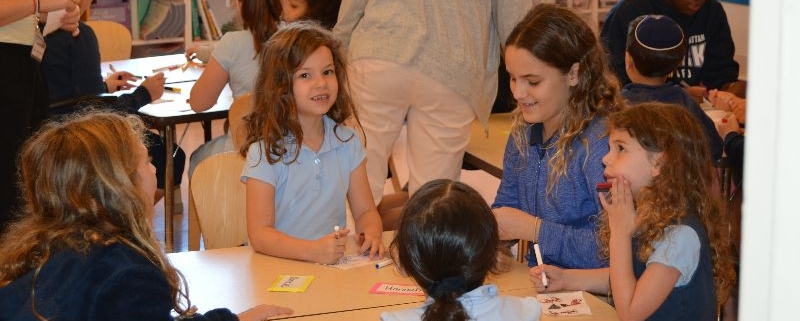Tikkun Chinuch: Reflecting on Our Own Educational Experiences to Better Our Children’s Learning, and the World.
By Debbie Nehmad, Fourth Grade Teacher
A few weeks ago in a fourth grade Theme class on the Lenape Indian tribe, students engaged in an impassioned discussion. One student had referred to the Lenape society as “primitive,” and others argued that their architectural feats were actually even more impressive than our own because they were achieved without electricity, motors, and iron. It was the kind of conversation that often puts adults on edge. How do we simultaneously allow students to express their opinions while guiding them away from judgmental language and thinking? Even more challenging, how do we achieve this while making sure not to let our own triggers and righteous zeal enter the conversation? Such is the task of the “social justice educator,” a label that has come to describe the heart of my role as a teacher.
My very first year in the classroom was as an assistant teacher in a Modern Orthodox day school. I wasn’t sure yet at that point whether I should pursue education as a career, but I knew that in order to feel fulfilled intellectually and emotionally, my path would also have to help me engage in the mission of tikkun olam (“repairing the world.”) It wasn’t until I had an emotional conversation with a sixth grade boy about his concerns over a Rashi commentary with sexist implications that I realized the tremendous potential that existed in the role of a teacher to foster social justice-oriented conversations with children and adolescents. What’s more, this discussion also made me realize how little my own schools had done to foster this kind of questioning and discourse. Suddenly, it became clear to me that my participation in tikkun olam could actually come about through a process of tikkun chinuch— a reparation of education.
This new way of thinking about my work invigorated and inspired me, but it also presented many of its own challenges and worries. What if I couldn’t think of a tactful way to respond to questions like these from my students? Or worse, what if I didn’t actually know enough to be able to respond with knowledge grounded in facts rather than mere emotion? Many of the important and charged comments I heard from students forced me to confront the gaps in my own learning or experience. After all, I couldn’t possibly discuss and unpack the variety of conversations about ableism, sexism, and racism that arose if I, myself, didn’t have a sense of the historical, attitudinal, and political structures that were maintaining them. Helping my students delve into these important topics meant having to face and transcend my own education as well.
As though the practical work of educating myself didn’t feel burdensome enough, this task takes a fair amount of emotional work as well, whether it’s pushing aside feelings of blame, resentment, or frustration about my own education; anxiety that I’ll “say something wrong” when I ask important questions; or general paralysis at how enormous the mission as a whole can feel. Despite all of this, accepting the responsibility of educating myself was a critical first step in being able to help my students learn better than I had. I realized that if I were to explore the gaps in my own learning as they revealed themselves, little by little, suddenly this mammoth undertaking can feel more attainable. Asking questions like, Why did that comment feel wrong to me? What’s the history of this particular social disparity I notice? Why is my library filled with authors of mostly the same race or gender? are all ways I can begin to repair what it is I may have missed along the way in my own education. Slowly but surely, I can come to close the gaps.
Once again this year, through the fourth grade Theme curriculum, I have the blessed opportunity to confront challenges such as these. How do I do justice to the Lenape culture and history when I myself feel so much distance from this critical period in time? Perhaps more weighty still, as I look ahead within the curriculum, how do I also teach about the arrival of the Dutch to New York, the reality of how they changed this land and its people, while neither ignoring the lessons of race that are sure to arise nor implicating today’s children in the horrors of long ago? I will again need to channel one of the most challenging and imperative acts of tikkun chinuch— the ability to allow students to express opinions or questions that make me uncomfortable, the ones that instantly rub up against the beliefs I hold dear. It is in those moments that we must be able to meet genuine questions with open inquiry. What does the word “primitive” mean? What connotations does it carry? Who usually uses that word and whom does it generally describe? What inferences can we make about this particular adjective based on those answers? Although these questions don’t always have clear answers, encouraging students to think about them helps them to see that history is complex. This understanding alone can lay the groundwork for the type of thought and discussion that, I believe, can truly better the world we live in.
With social justice at the heart of my teaching, I have been pushed to realize that when we feel we lack the language to discuss difficult conversations, it’s our job to find it, to use it, and to share it with our children so that they can participate in these conversations as well. As I excitedly (if somewhat anxiously) work to pursue the knowledge I missed growing up, I feel grateful to be part of a school that strives to help our students have these honest, intellectual, and meaningful discussions so that they might grow into socially responsible adults better informed than ourselves.
Shabbat shalom
Debbie Nehmad
Fourth Grade Teacher



